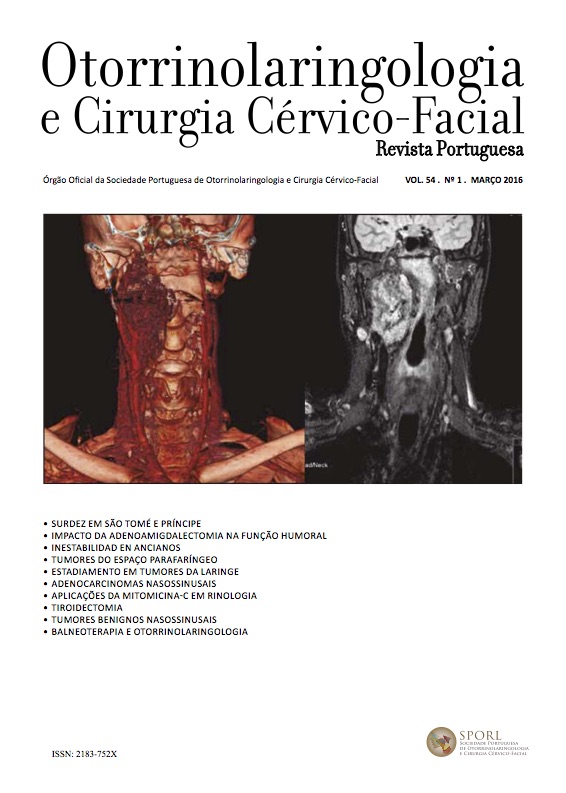Balneoterapia e Otorrinolaringologia - Revisão Sistemática
DOI:
https://doi.org/10.34631/sporl.552Palavras-chave:
Balneoterapia, Rinossinusite, Água mineral naturalResumo
Introdução: A Balneoterapia foi definida recentemente como o uso de águas minerais naturais para aplicação terapêutica. Este trabalho tem como objetivo realizar uma revisão bibliográfica sistemática da balneoterapia na patologia do foro Otorrinolaringológico (ORL).
Materiais e Métodos: Foi realizada uma revisão bibliográfica sistemática baseada no modelo PRISMA (Preferred Reporting Items for Systematic Reviews and Meta-Analyses) seguindo a estrutura hierárquica dos 5 Ss conceptualizada por Haynes, que representa uma pirâmide com cinco níveis de organização da evidência. Consultaram-se ainda websites relevantes de associações de hidrologia médica.
Resultados: Atualmente, existe evidência para uso da terapêutica hidrológica em doenças ORL. Os resultados mais relevantes consideram o papel terapêutico das águas sulfúreas e cloretadas sódicas na rinite e sinusite em crianças e adultos. Outro papel relevante é na melhoria dos parâmetros audiométricos em crianças com otite média com efusão.
Conclusões: A evidência científica recente demonstra que a terapêutica termal é, de facto, baseada em fundamentos científicos consistentes. É necessário o desenvolvimento de mais ensaios randomizados e controlados para a inclusão desta abordagem terapêutica em guidelines clínicas.
Downloads
Referências
Mooventhan A, Nivethitha L. Scientific evidencebased effects of
hydrotherapy on various systems of the body. North Am J Med Sci
:199-209
Balint G, Bender T, Szabó E. Spa treatment in arthritis. JRheumatol.
:1623-1625
Seidman MD, Gurgel RK, Lin SY, Schwartz SR et al. Clinical Practice
Guideline: Allergic Rhinitis. Otolaryngology– Head and Neck Surgery.
:1-43
Rosenfeld RM, Piccirillo JF, Chandrasekhar SS, Brook I et al. Clinical
Practice Guideline (Update): Adult Sinusitis. Otolaryngology– Head
and Neck Surgery. 2015. 4:1-39
Haynes RB. Of studies, syntheses, synopses, summaries, and
systems: the “5S” evolution of information services for evidencebased
healthcare decisions. Evid Based Med. 2006. 11:162-164
Passali D, De Corso E, Platzgummer S, Streitberger C et al. Spa therapy
of upper respiratory tract inflammations. Eur Arch Otorhinolaryngol.
(2):565-70
Staffieri A, Marino F, Staffieri C, Giacomelli L et al. The effects of
sulfurous-arsenical-ferruginous thermal water nasal irrigation in
wound healing after functional endoscopic sinus surgery for chronic
rhinosinusitis: a prospective randomized study. American Journal of
Otolaryngology–Head and Neck Medicine and Surgery. 2008. 29:223–229
Staffieri A, Abramo A. Sulphurous-arsenical-ferruginous (thermal)
water inhalations reduce nasal respiratory resistance and improve
mucociliary clearance in patients with chronic sinonasal disease:
preliminary outcomes. Acta Otolaryngol. 2007. 127(6):613-7
Giancarlo Ottaviano, Gino Marioni, Luciano Giacomelli, Fabio Biagio
La Torre et al. Smoking and chronic rhinitis: effects of nasal irrigations
with sulfurous-arsenical-ferruginous thermal water. A prospective,
randomized, double-blind study. American Journal of Otolaryngology–
Head and Neck Medicine and Surgery. 2012. 33:657–662
Ottaviano G, Marioni G, Staffieri C, Giacomelli L et al. Effects of
sulfurous, salty, bromic, iodic thermal water nasal irrigations in
nonallergic chronic rhinosinusitis: a prospective, randomized, doubleblind,
clinical, and cytological study. American Journal of Otolaryngology–
Head and Neck Medicine and Surgery. 2011. 32:235–239
Miraglia Del Giudice M, Decimo F, Maiello N, Leonardi S et al.
Effectiveness of Ischia Thermal Water nasal aerossol in children with
seasonal allergic rhinitis: a randomized and controlled study. Int. J.
Immunopathol. Pharmacol. 2011. 24:1105-1111
Passali D, Lauriello M, Passali GC, Passali FM et al. Clinical evaluation
of the efficacy of Salsomaggiore (Italy) thermal water in the treatment
of rhinosinusal pathologies. Clin Ter. 2008. 159(3):181-188
Cantone E, Marino A, Ferranti I, Castagna G et al. Nasal cytological
assessment after crenotherapy in the treatment of chronic
rhinosinusitis in the elderly. Int J Immunopathol Pharmacol. 2014.
(4):683-7
Fenu G, Bozzo C, Carai A, Delehaye E et al. Effects of Isotonic Salso-
Bromo-Iodine Thermal Water After Sinunasal Surgery: A Preliminary
Morphological Study. The journal of alternative and complementary
medicine. 2010. 16(4):341-343
Pagani D, Galliera E, Dogliotti G, De Bernardi di Valserra M et al.
Carbon Dioxide-enriched Water Inhalation in Patients with Allergic
Rhinitis and its Relationship with Nasal Fluid Cytokine/Chemokine
Release. Archives of Medical Research. 2011. 42:329-333
Passariello A, Di Costanzo M, Terrin G, Iannotti A et al. Crenotherapy
modulates the expression of proinflammatory cytokines and
immunoregulatory peptides in nasal secretions of children with
chronic rhinosinusitis. Am J Rhinol Allergy. 2012. 26:e15-9
Friedman M, Hamilton C, Samuelson CG, Maley A et al. Dead Sea
salt irrigations vs saline irrigations with nasal steroids for symptomatic
treatment of chronic rhinosinusitis: a randomized, prospective
double-blind study. Int Forum Allergy Rhinol. 2012. 2(3):252-7
M. Costantino, E. Lampa, G.Nappi. Effectiveness of sulphur spa
therapy with politzer in the treatment of rhinogenic deafness. Acta
Otorhinolaryngol Ital. 2006. 26:7-13
Costantino M. The rhinogenic deafness and SPA therapy: clinicalexperimental
study. Clin Ter. 2008. 159(5):311-5
Tozzi A , Blancasio AC, Basagni C, Ricci C et al. Prevention and cure
of rhinogenous deafness at the Thermal Baths "Bagni delle Galleraie".
J Prev Med Hyg. 2006. 47(4):146-50
Califano L, Salafia F, Mazzone S, D'Ambrosio G et al. A comparative
randomized study on the efficacy of a systemic steroid therapy vs a
thermal therapy in Otitis media with effusion in children. Minerva
Pediatr. 2014:13
Olina M, Aluffi Valletti P, Pia F, Toso A et al. Hydrological indications
in the therapy of pharyngitis. Recenti Prog Med. 2008. 99(6):314-21
Costantino M, Rossi F, Lampa E. Inhalation therapy with sulphur
water in ORL: clinical-experimental study. Clin Ter. 2003. 154(6):395-400






